ALLIGATOR BEHAVIOR page 5l: BABY
ALLIGATORS --page 12 Alligator nests and babies page 1
2
3
4
5
6
7
8
9
10
11
This
page
was born 02/14/2024. Rickubis designed it. Last
update: 02/04/2025
Images
and
contents on this page copyright ©2025 Richard M. Dashnau
Most
of these were posted on the RICKUBISCAM
page first, then moved here. Unlike most of my other
pages, the entries on this page will be shown in chronological
order from top to bottom
(since this makes following the progression of events easier),
so scroll to the bottom to see the latest posts. This may
require a lot of scrolling,
depending on how often I've recorded events--but I hope that
you'll enjoy the journey.
01/12/2025
BBSP had
been very dry 2022 - 2024, with some
of the lakes completely dry for up
to a few months before getting some
water in the winter, then drying
again.
The morning was chilly (I didn't
think to take a temperature reading). About 30
minutes later,near the Observation
Tower, I found an alligator avoiding
the cold air by only
exposing its nostrils while it
breathed. The alligator had a few
markings that made me think it might
have been a female alligator that
had been guarding a pod of babies in
the same area a few years ago. I'm
placing the observation on this
page, just in case.
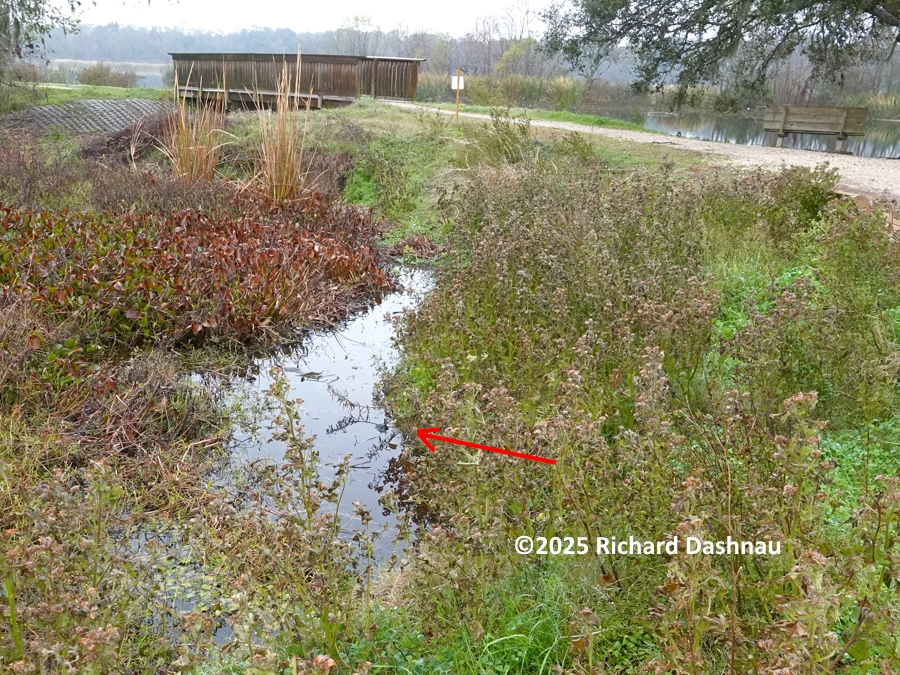

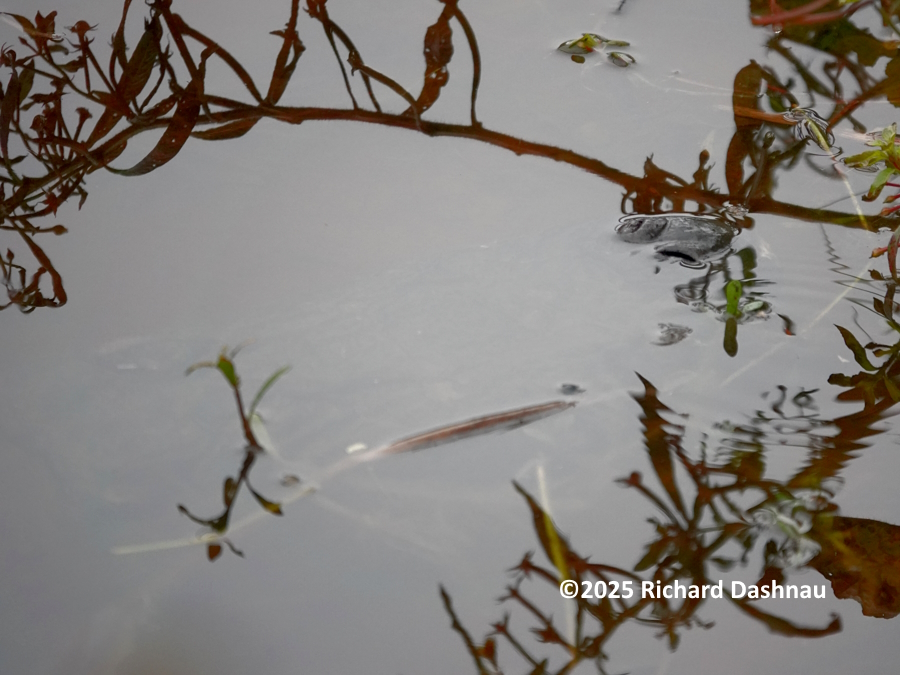
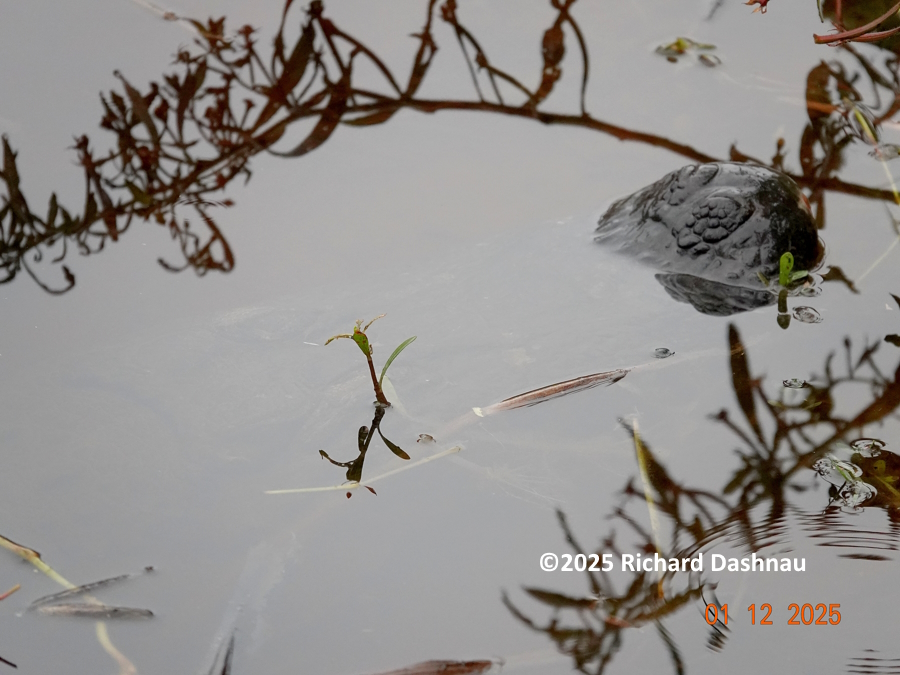
The only
reason I'd found it for this set of
images was because I'd seen it
surface once already. Otherwise, I
would have never noticed the
alligator. It was a
wonderful
demonstration of how alligators deal
with cold weather.
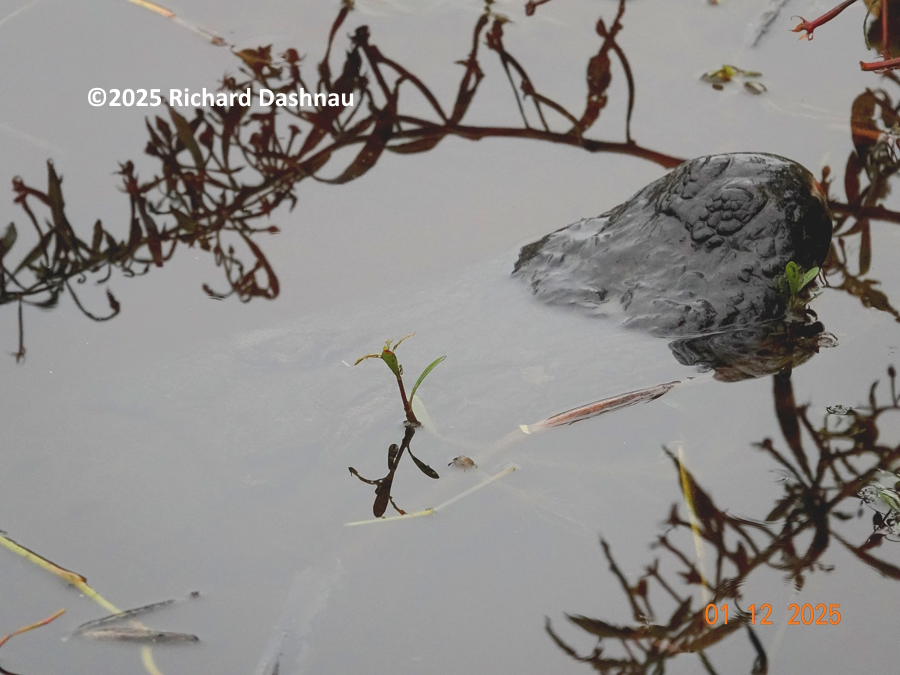
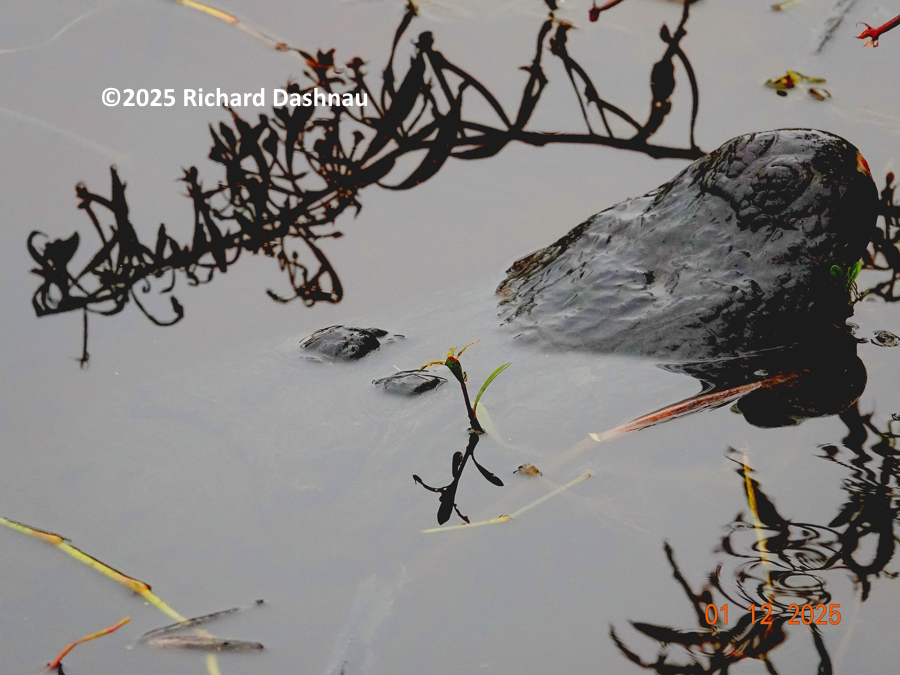
01/21/2024 It was cold again at BBSP. When I
checked the temperature at the Forty Acre Parking Lot, it was 39.2°F,
almost the same as the previous
weekend. But the air on this
day was very damp. This damp air, when moving, can draw the heat right
out of me. It's always colder down near the Observation Tower, mostly
because of the wind blowing off of Pilant Lake. The morning was
overcast, and the air was hazy--which is further indication of hold
cold it would feel.
While heading back West on the Spillway
Trail I found the mother alligator (as far as I know) where I'd last
seen her, on the South side of the trail. No sign of any babies.
The
history of this pod up to this day is shown on this page.
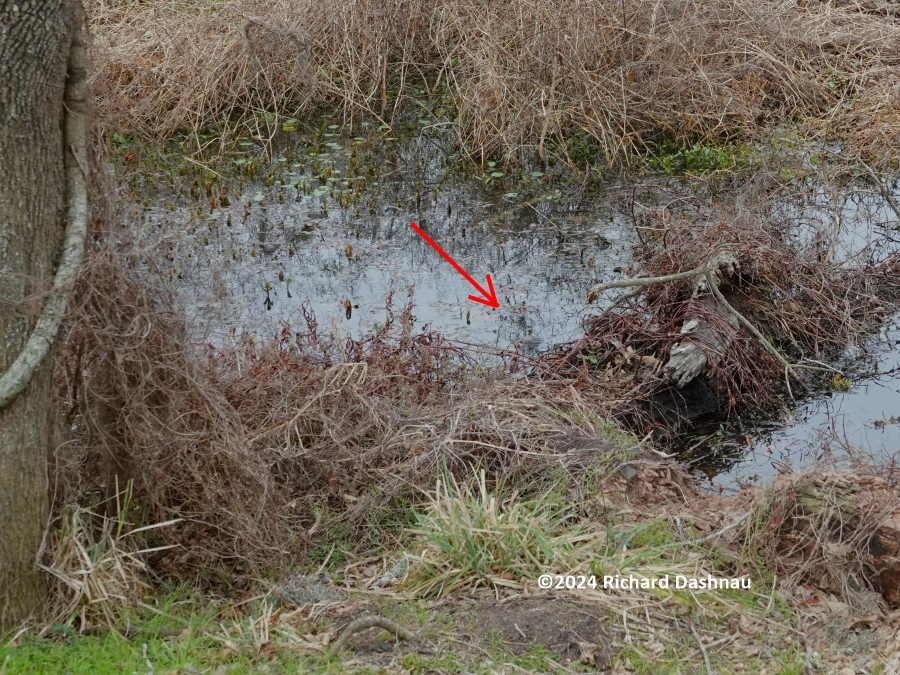
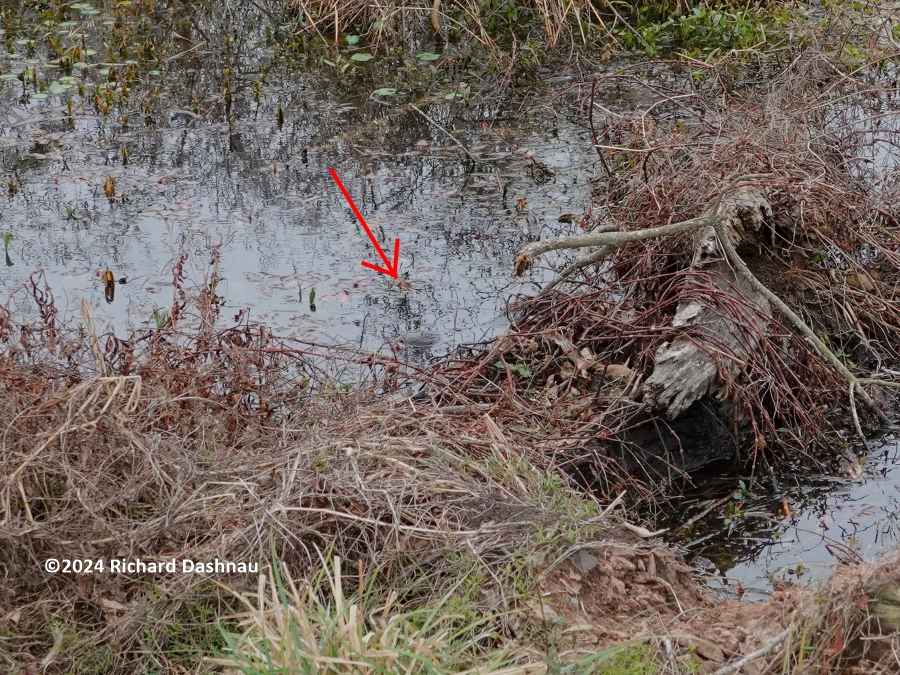

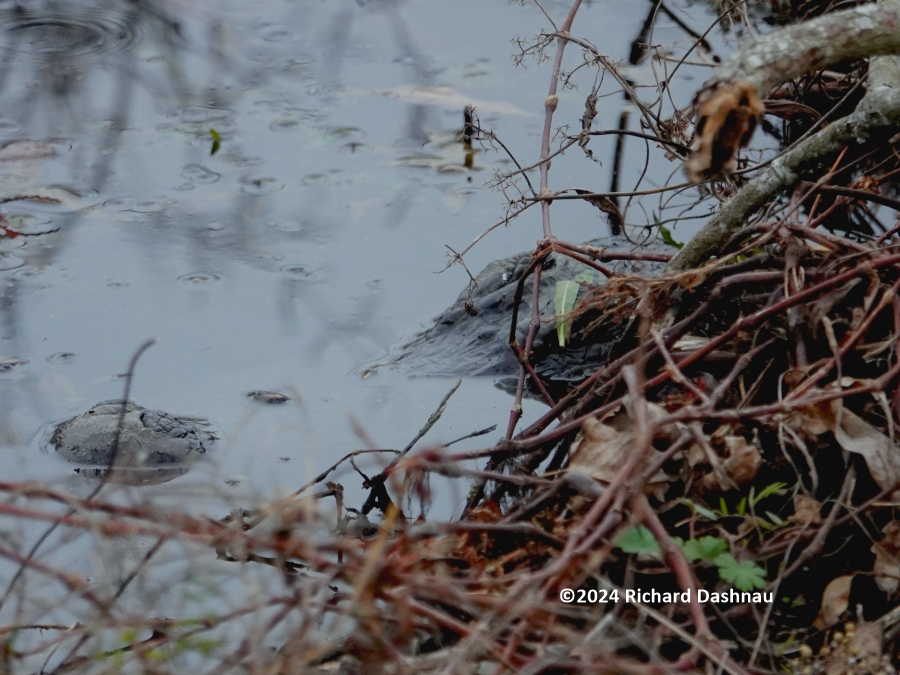
01/28/2024
Good
news! We got some water at Brazos Bend State Park. We almost got too
much, since the Brazos River got close to flood stage at
the river gage at Rosharon (about 45 feet).
Big Creek rose enough to overflow into Hale Lake and fill that very
nicely (though I didn't go look, since it that area of the park
was still flooded.) But that water didn't really go much further
into the park. Instead, the direct rain that fell on Pilant Lake and
Elm Lake brought up the water levels there,
and along Pilant Slough. I observed that myself. So, here are a
few images from that wonderful sunny day.
It was cold (44.7°F) up at the 40Acre Parking lot. Although
it's usually colder down on the trails, I was also hoping that the
sunny day would warm things a bit. Through
the past months, I've been stopping just East of the Observation Tower
and taking pictures across Pilant Lake. It looked great today!
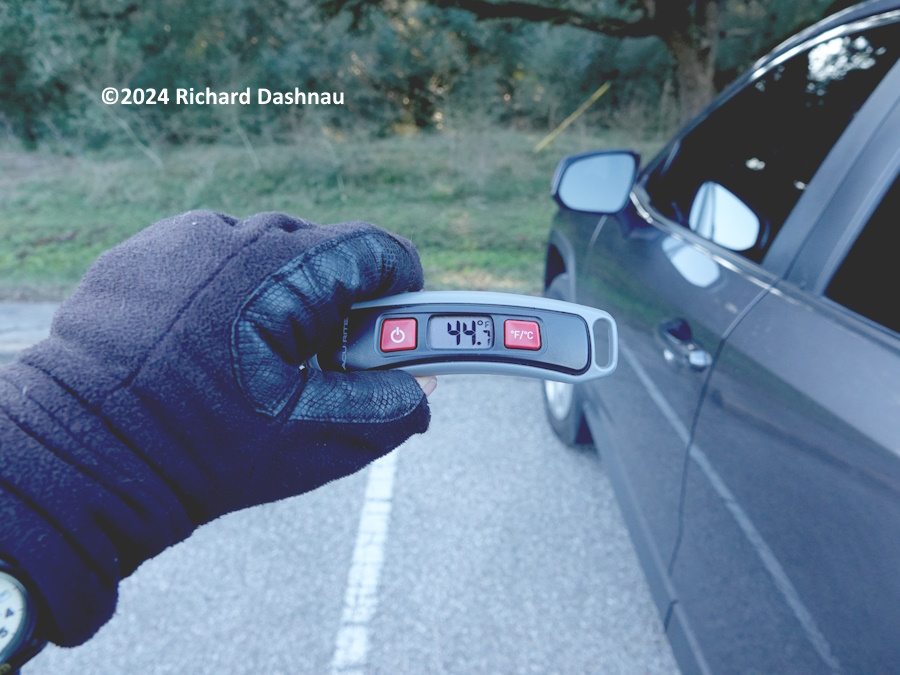
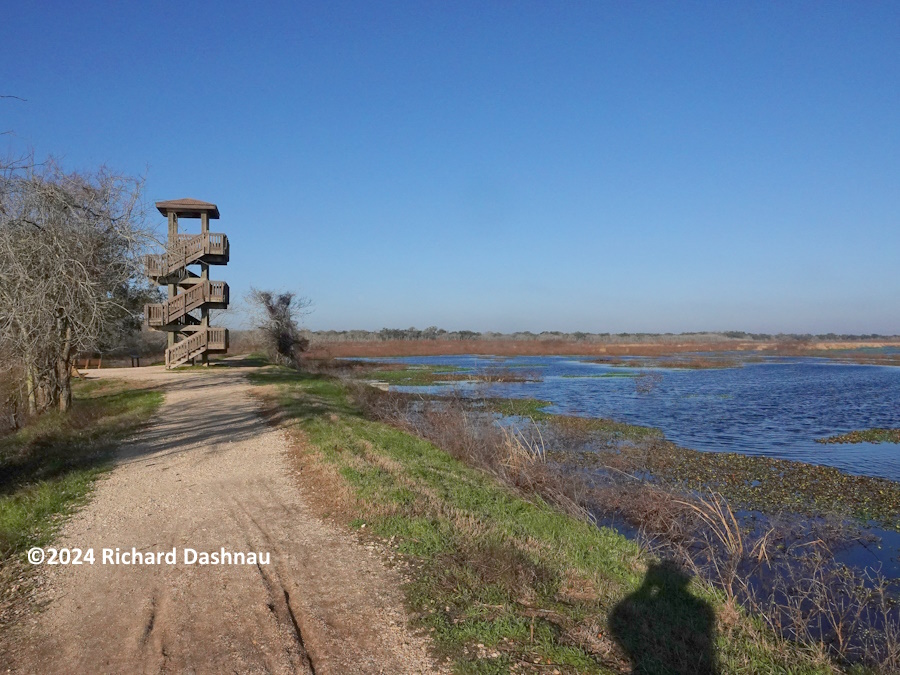

One might be asking, "What about the
alligators? How did they cope with the added water? I found the mother gator that had the pod
just East of the Spillway as I was
moving towards Elm Lake near 10am. She was still South of the
trail, but I didn't see any babies at first. When I returned to the
spot about 2:30pm I saw a few of the
babies. I could hear some chirping from cover, and found a few hidden
among the weeds by using binoculars. A few of them came out of the
plants, and came out into
the open.
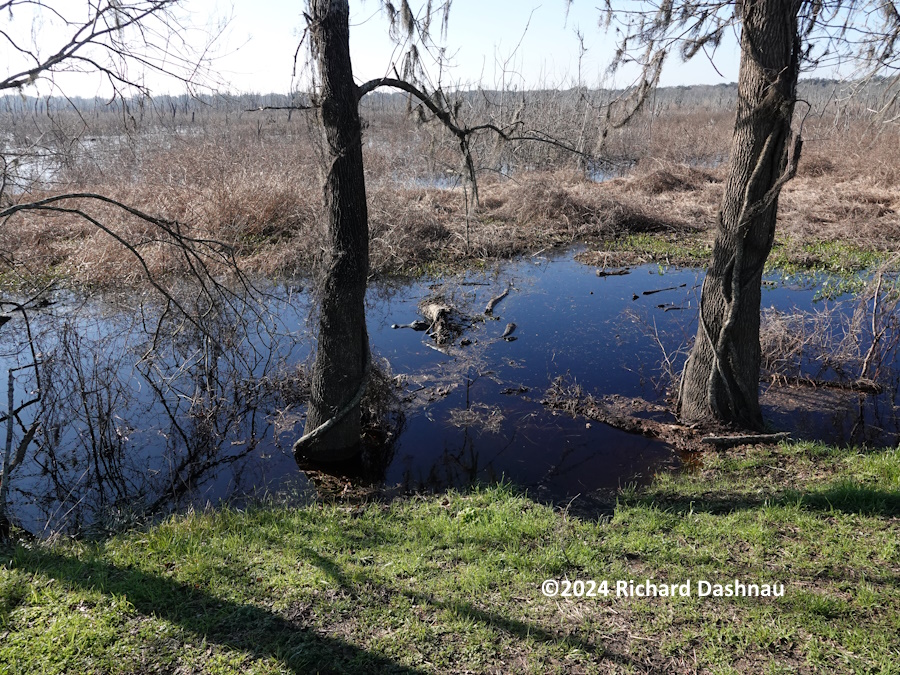
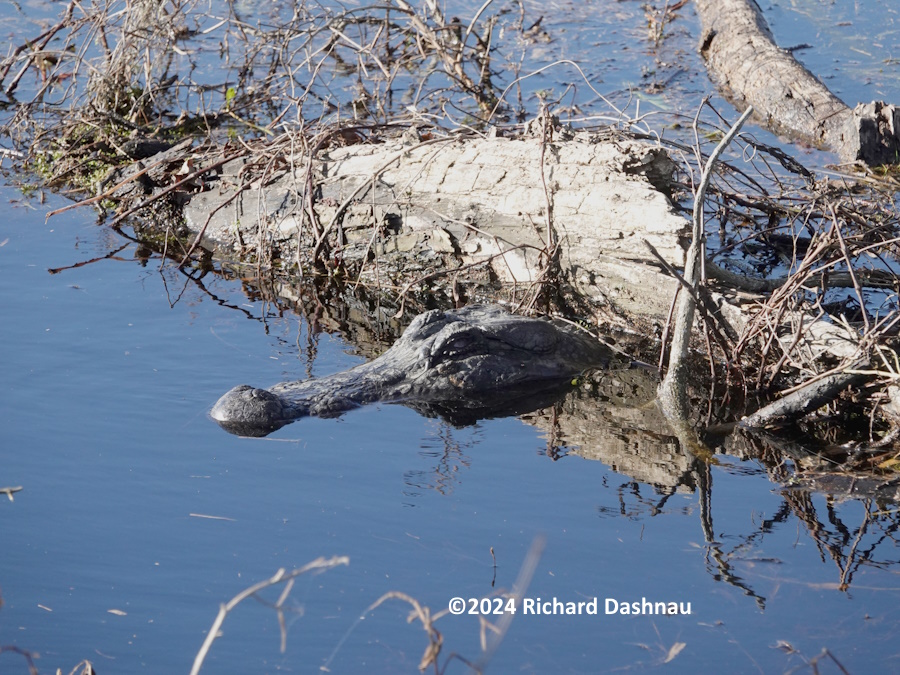
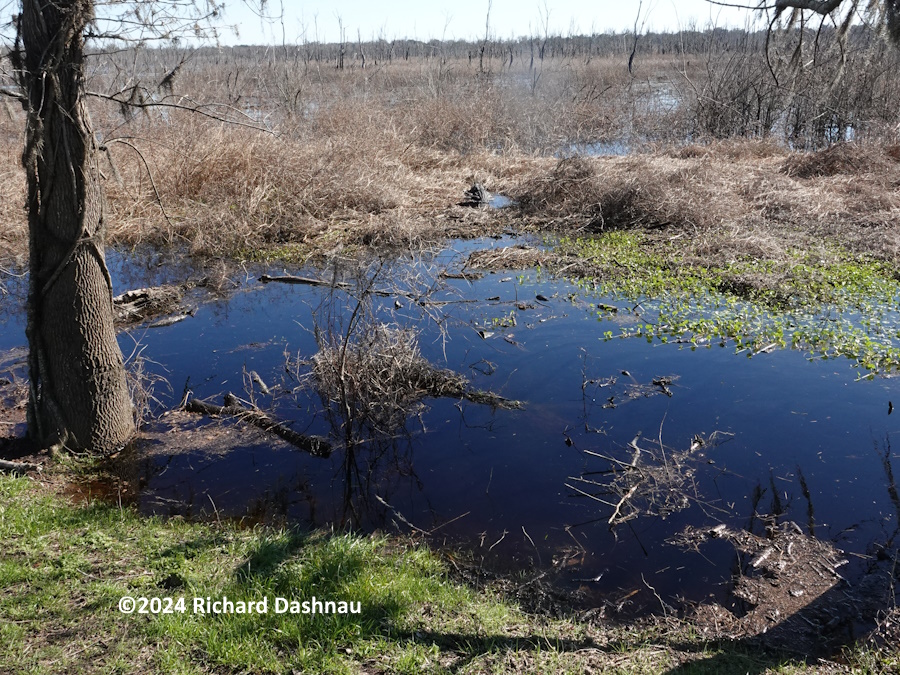
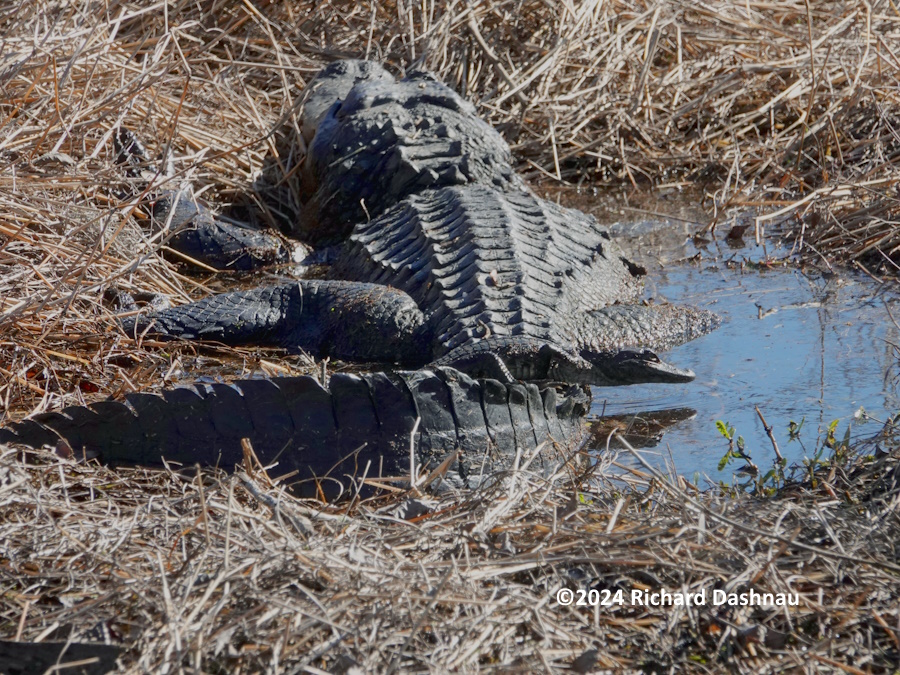
I estimate that the water level in Elm Like may have come up 2 or 3
feet. The "shelf" directly across from the trail end was under water
again. There was a large alligator on
the bank on our side, and I stayed near it for a few hours. Air
temperature was about 55°F when I got there, but the sunshine felt
warm. It was a great day!
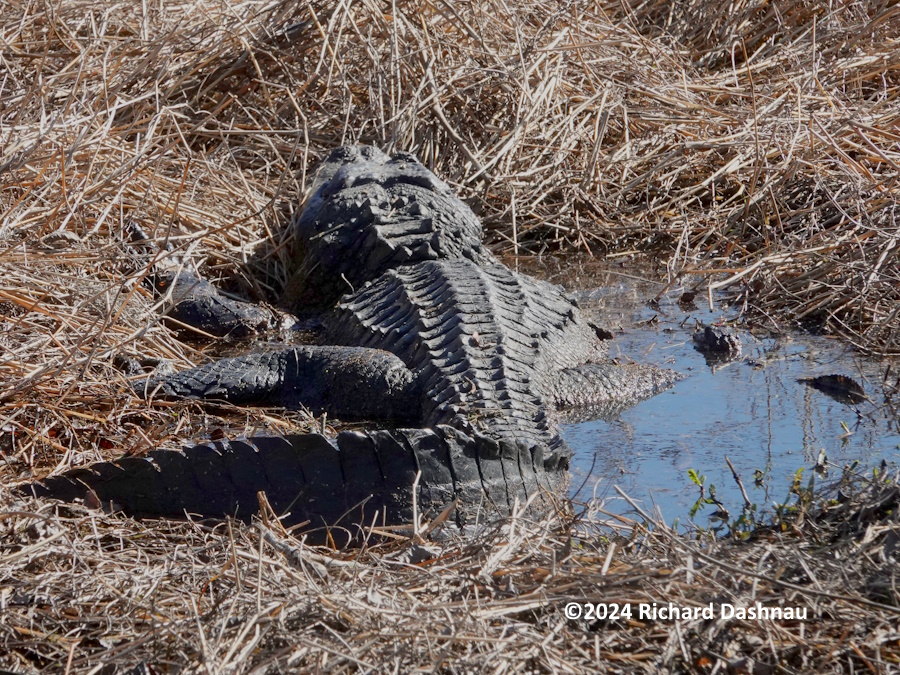
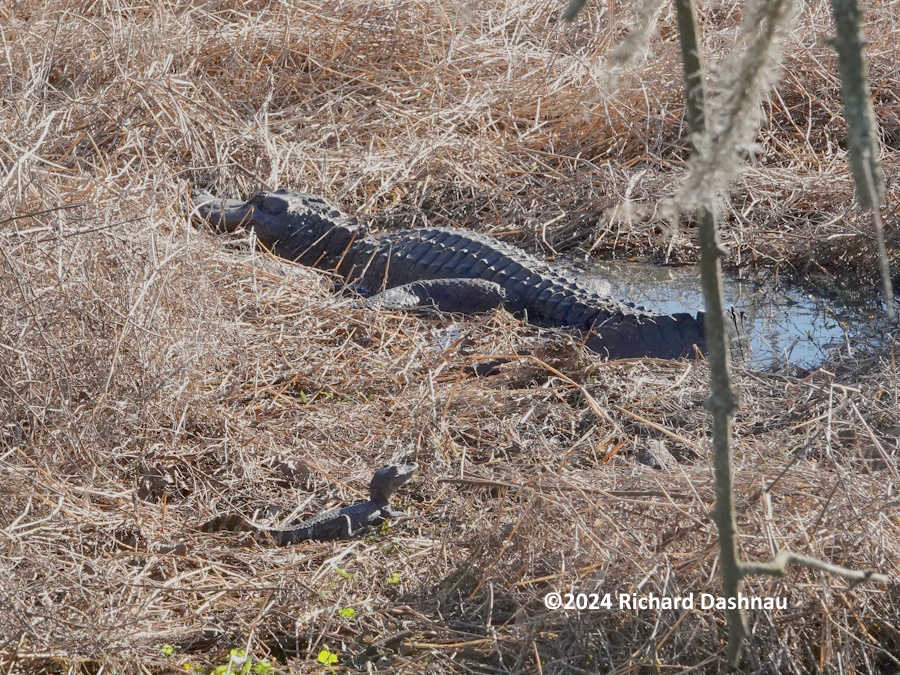
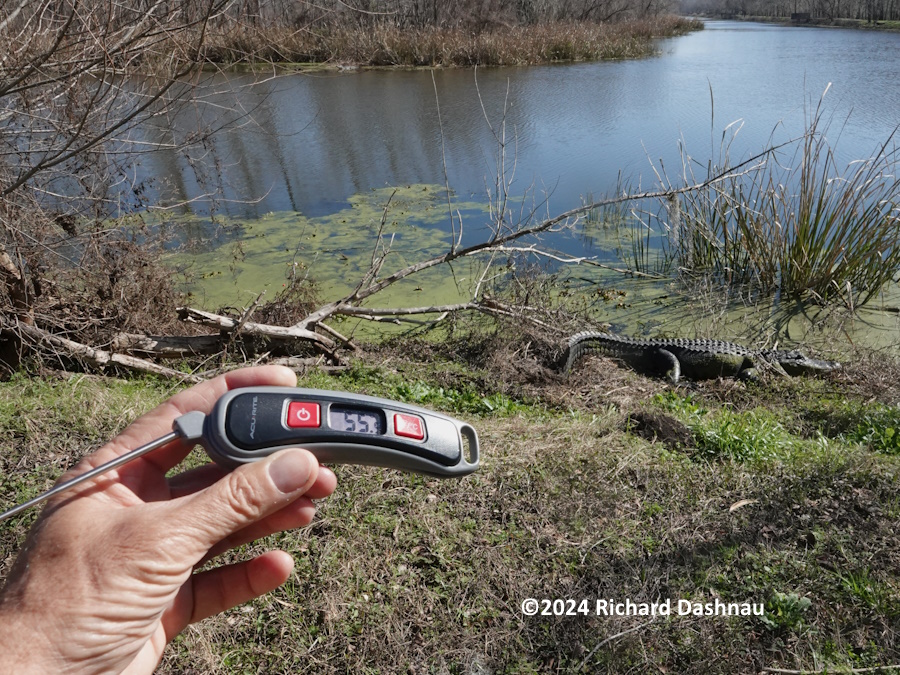
I stayed near the large alligator at Elm
Lake because it was the first opportunity I had to monitor a large
alligator basking close enough to use my thermal imager. So,
from 10:40am to 2:10pm I shot images when I thought about it
(meanwhile, I was also watching other alligators and wildlife, and
interpreting for park visitors). The images
below are screen shots of data I got from the images by using their
proprietary software. Although the alligator did warm up during the
day, I was hoping to see its temperature
change at a different rate than the surrounding area. Looking at
it this way may not give me the results I expected, since I can only
see external temperature. Of course
its skin and external surfaces would get warmer from the sun, and if
the alligator is exchanging cooler internal blood for warmed external
blood, the rate of flow wouldn't
show me much difference from the environment. What I probably
need to do is monitor the opposite condition--watching a warm
alligator as the area around it gets cooler.
I would expect an alligator to cool down slower (or not at all)
relative to the surfaces around it. This depends on the size and
mass of the alligator, and whatever it is lying upon.
Oh, well...I'll try again later.
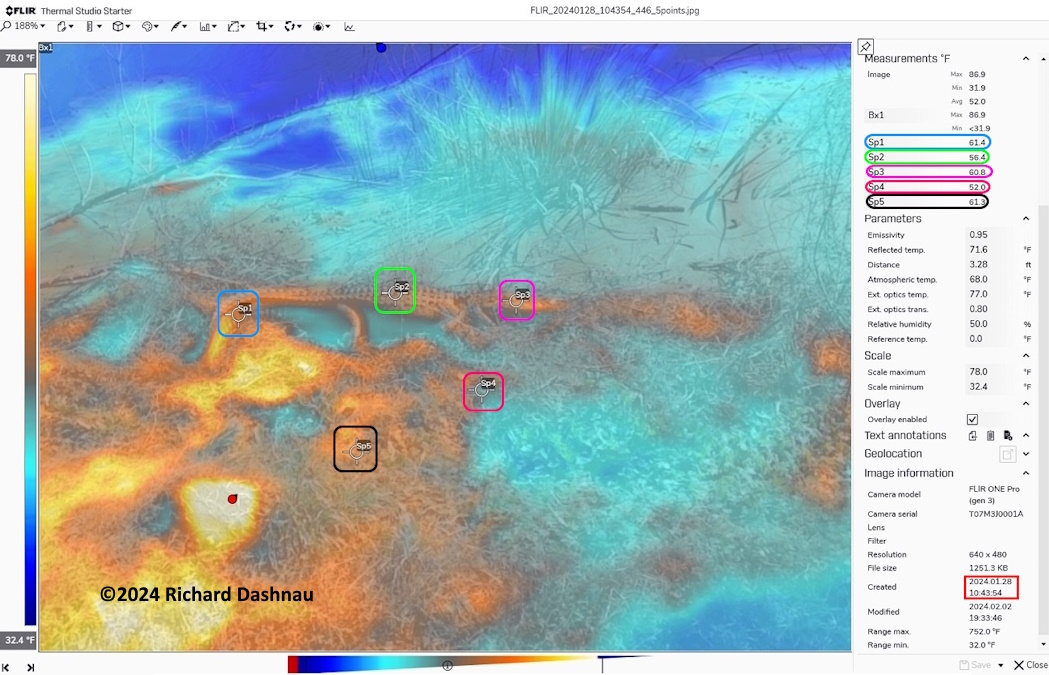
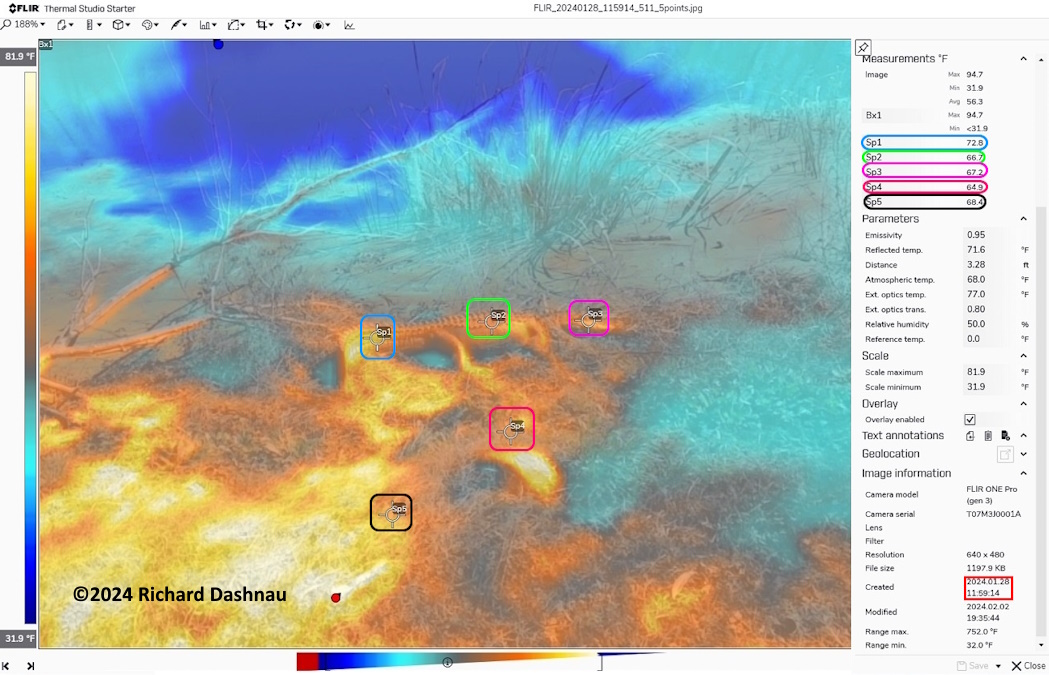
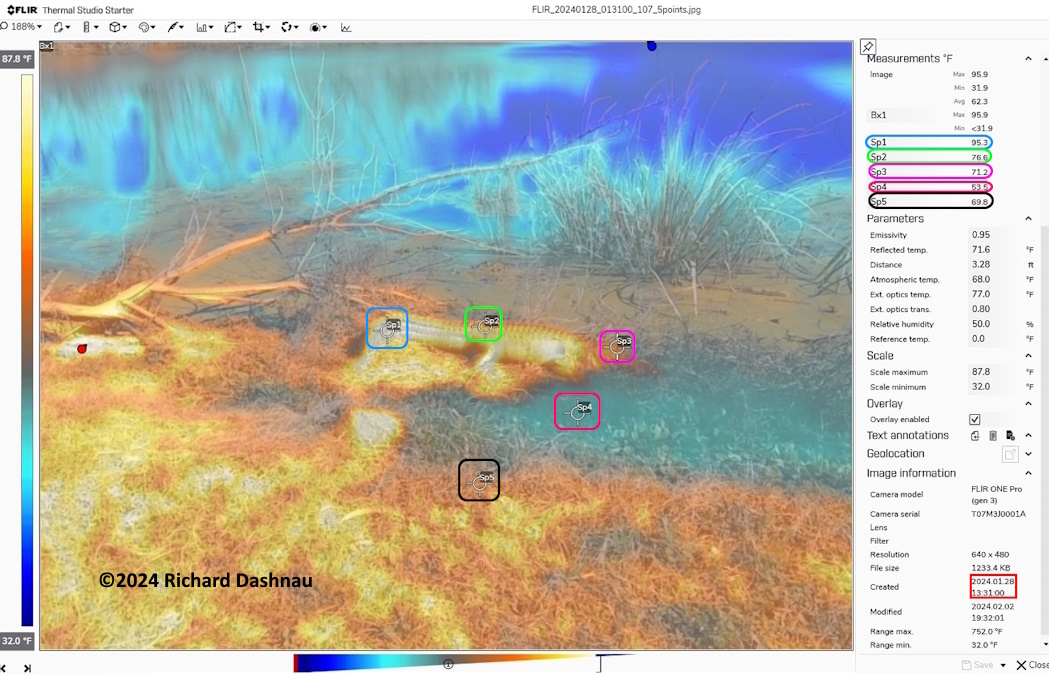
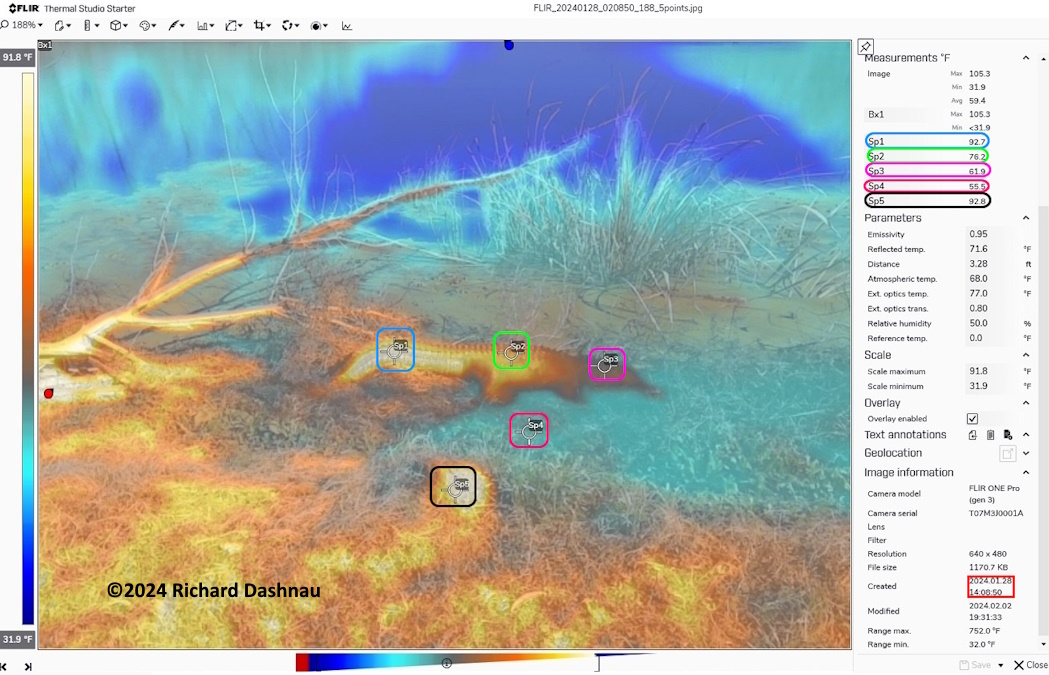
02/04/2024
An
update on the mom gator and her pod that I've been watching on the
Spillway Trail since last August (2023). The
higher water combined
with the warmer day to bring out more babies. Her story from last year
can be found mostly
on this page. When I
passed by her spot about 9:00am, I could hear few
babies chirping, and could find a few near her. One is near her
head in the first 3 images below. When I returned about
12:50pm there was a pile of babies on a floating
log while the mom was basking on the floating vegetation behind them.
This was South of the Spillway Trail.
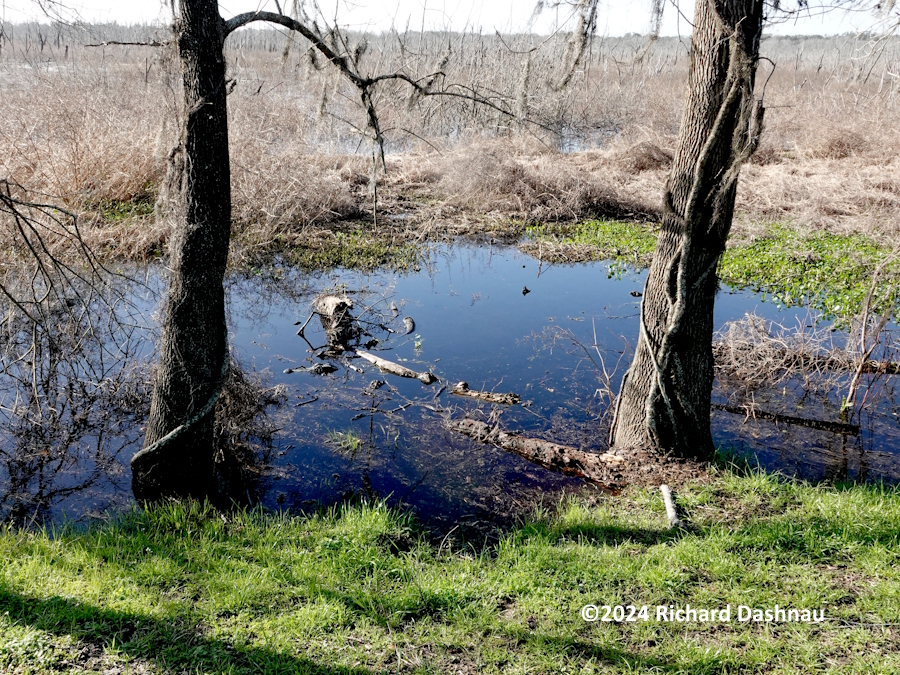
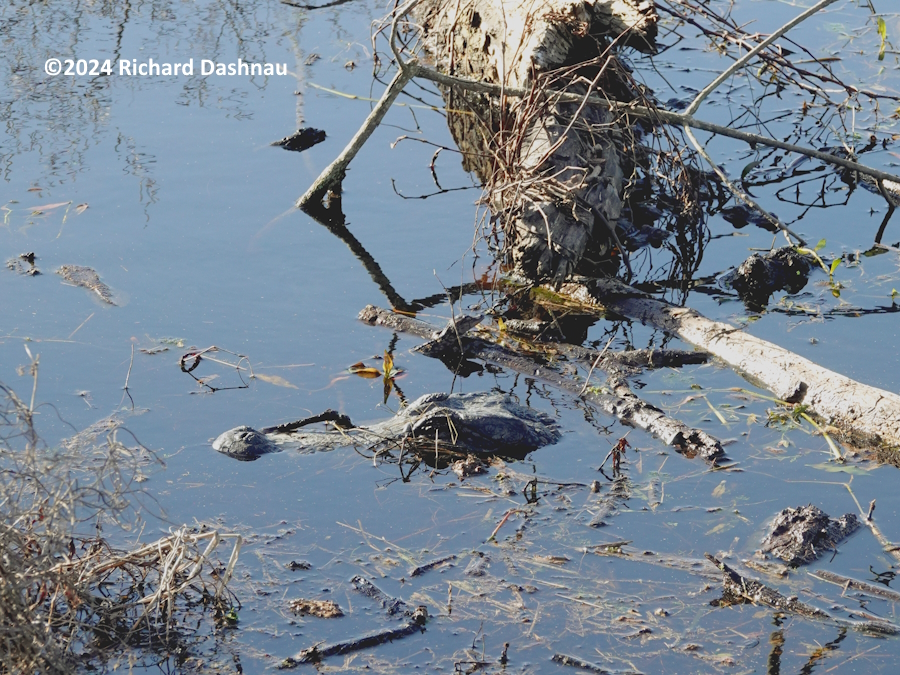
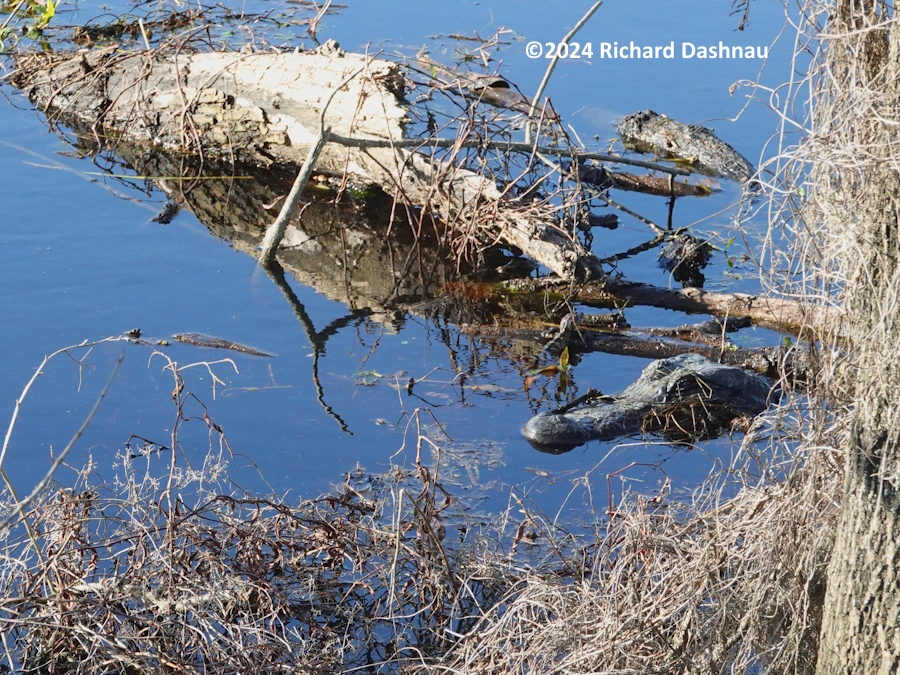
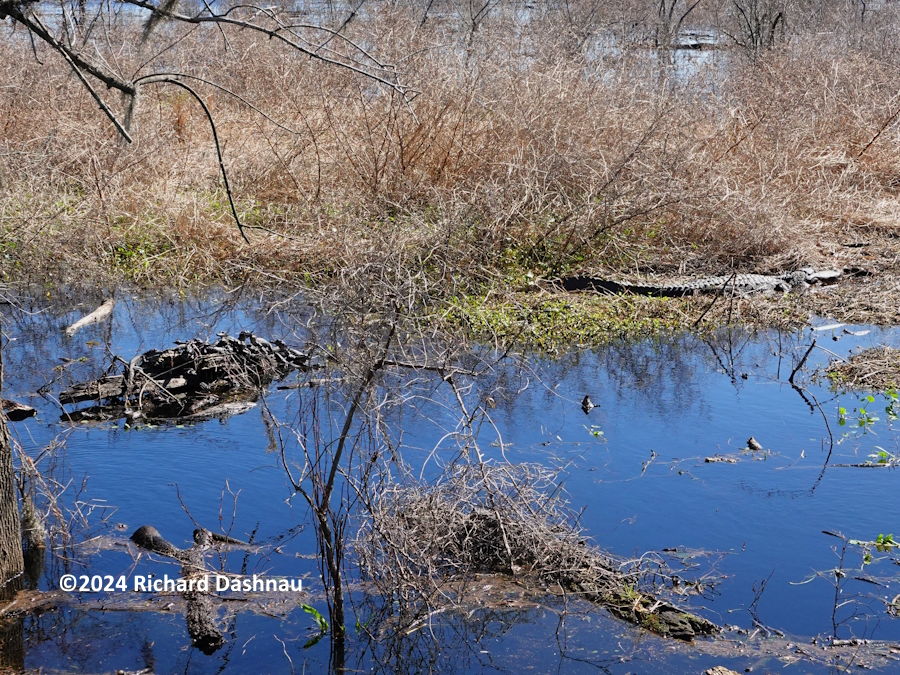
I spent a few hours near the pod. Most of
the babies stayed on the log, although the configuration of the pile
changed as the babies on the bottom tried to get on top, or
as new ones left the water to add to the pile. Park visitors often ask
how many there are, and it's always hard to count them in a situation
like this--even with binoculars.
Another question I've heard often since last year is if all of those
babies "belong" to that mother gator. It is most likely that
they are, although-as the summer progressed,
and the mother and pod occupied the only
open puddle within a few hundred yard-I considered that other small
gators might have followed the water and been adopted
by that mother gator. It was still most likely that they were hers,
from possibly 3 different hatchings (a year apart). BUT--that changed
sometime late November, 2023 when
5 babies that were hatched in our Nature Center were released to join
this pod. So, if nothing has happened to them, 5 of those babies are
certainly NOT hers.
Oh, and to get the best count of a pile of alligators, I have to take
a clear image, then go home and try to count their heads. The
first 2 images below demonstrate this.
In the second I've marked twenty-four
(24)
babies! I certainly couldn't see all of them while I
was out there!
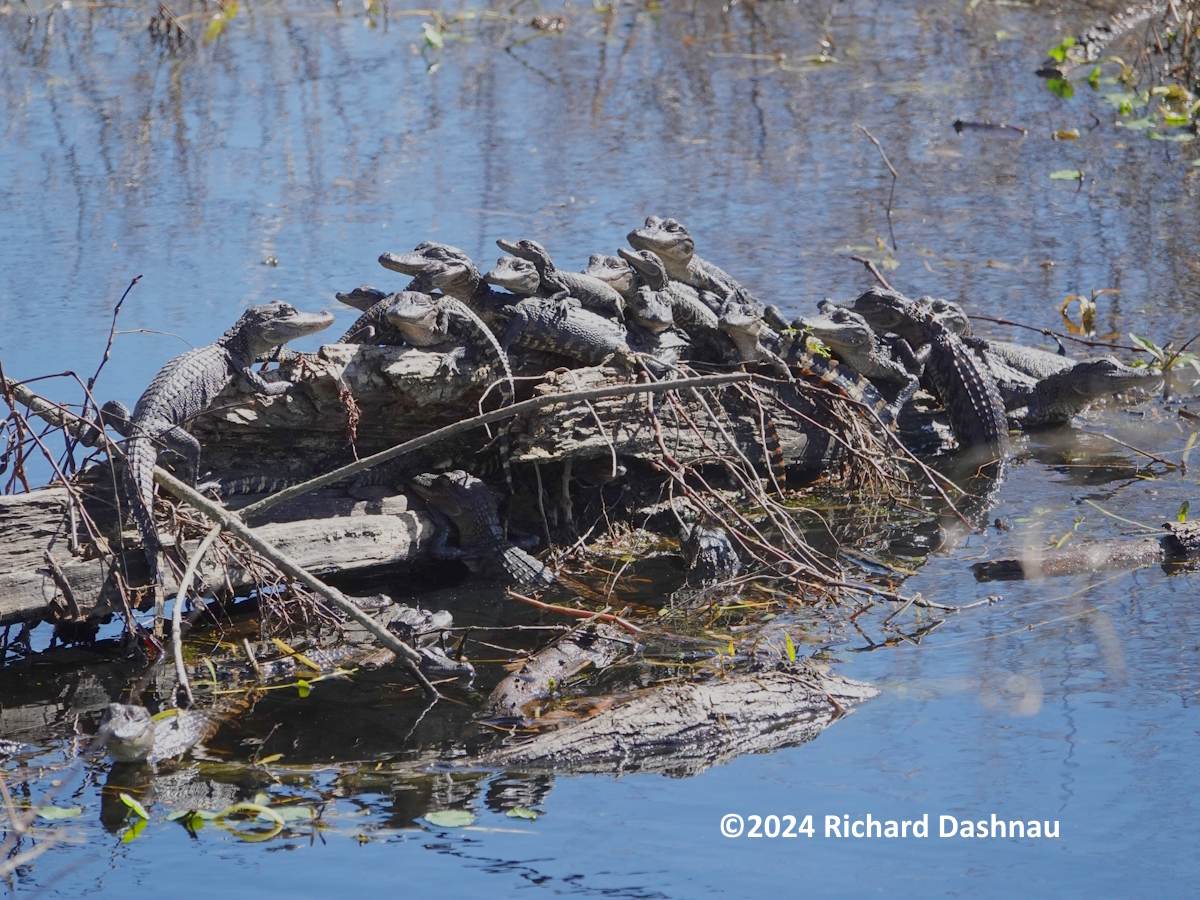
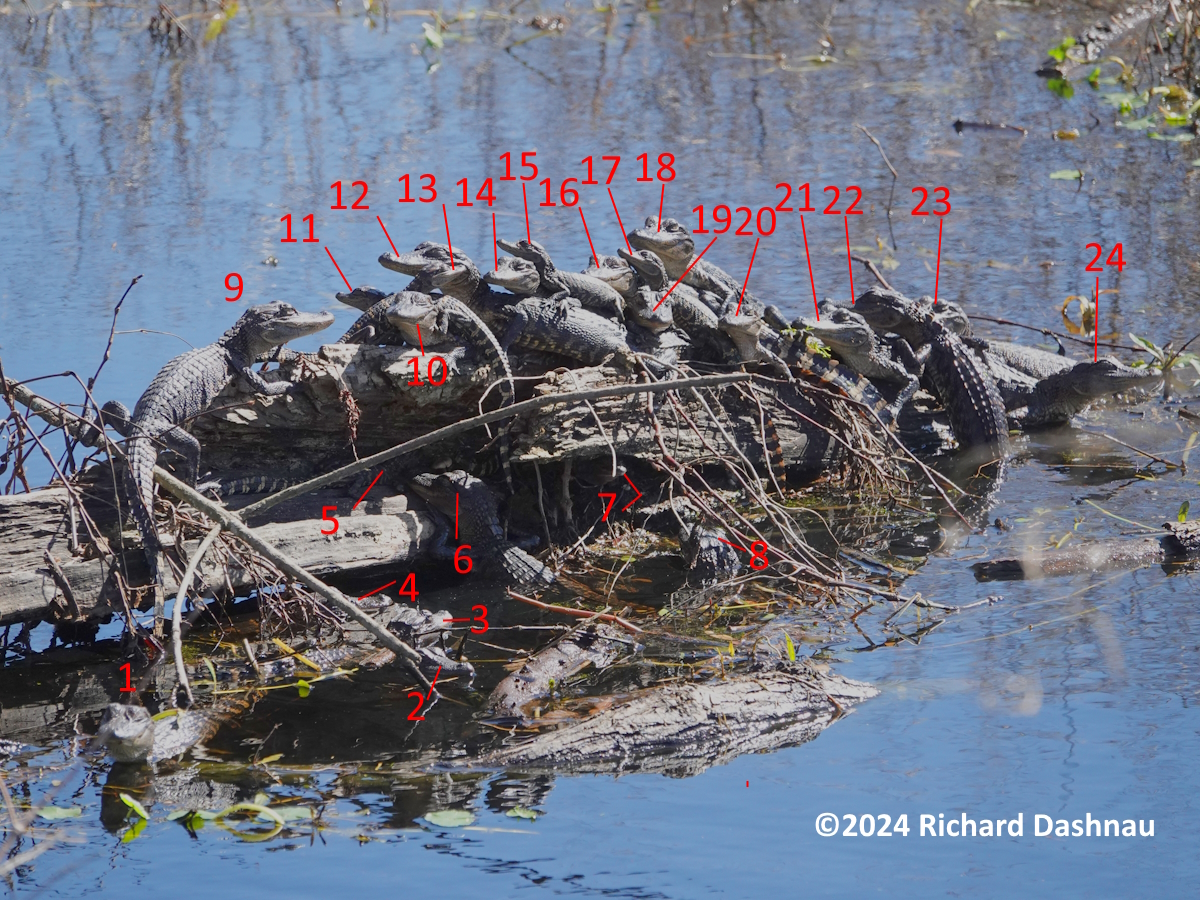
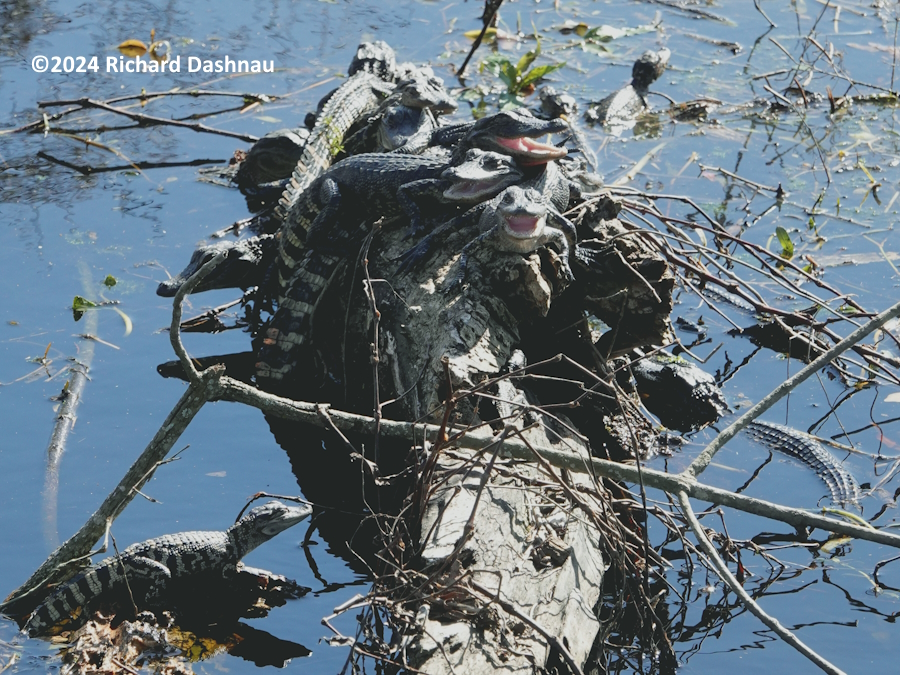
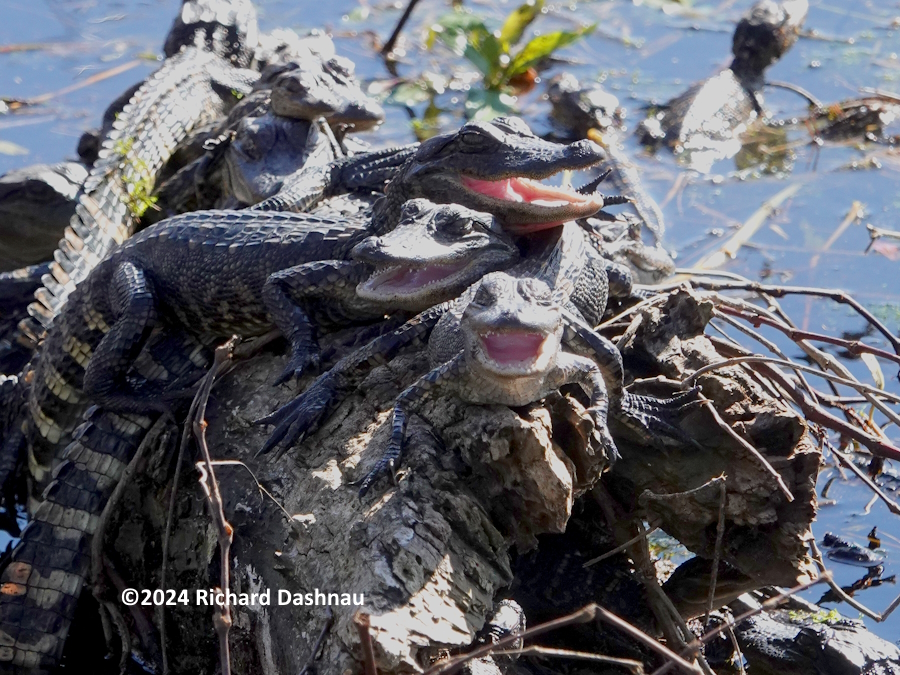
There are various reasons and sources for the baby gators that are
hatched in the Nature Center. Whatever the circumstances, the
babies hatched in there are protected
better than the wild babies for at least a year, before they are
released. If the release is to a mother alligator, I see are two
amazing things. First, is that the mother-guided
by the particular sounds of the chirps-is immediately protective of
the new babies and guides them to her. But I'm more surprised by
the babies accepting the mother.
They have never been outside for their entire year of life; yet they
recognize the mother alligator, chirp for her, and swim towards her!
How do they recognize her
as protection, and not as a predator to be feared? Another
interesting sight was on the North side of the Spillway Trail, where
the babies had been sheltering for a few
months last summer. The first two images below are thermal views
of the mom gator and pod.
The last
image below was taken on this
day 02/04/2024. An alligator was basking near the
remnants of the nest, while everything else is submerged.
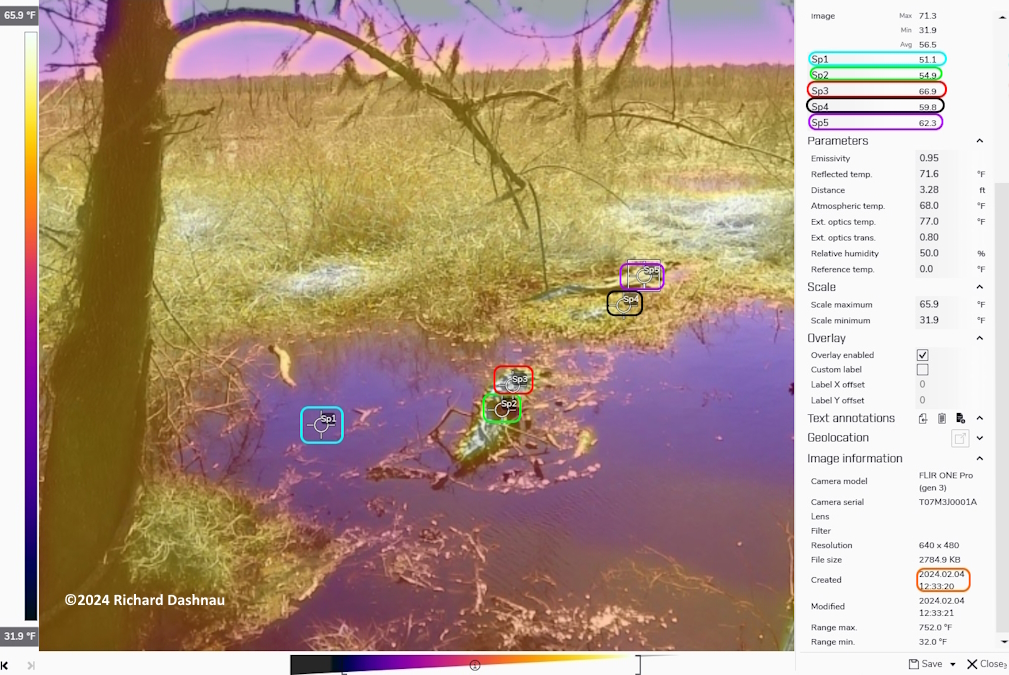
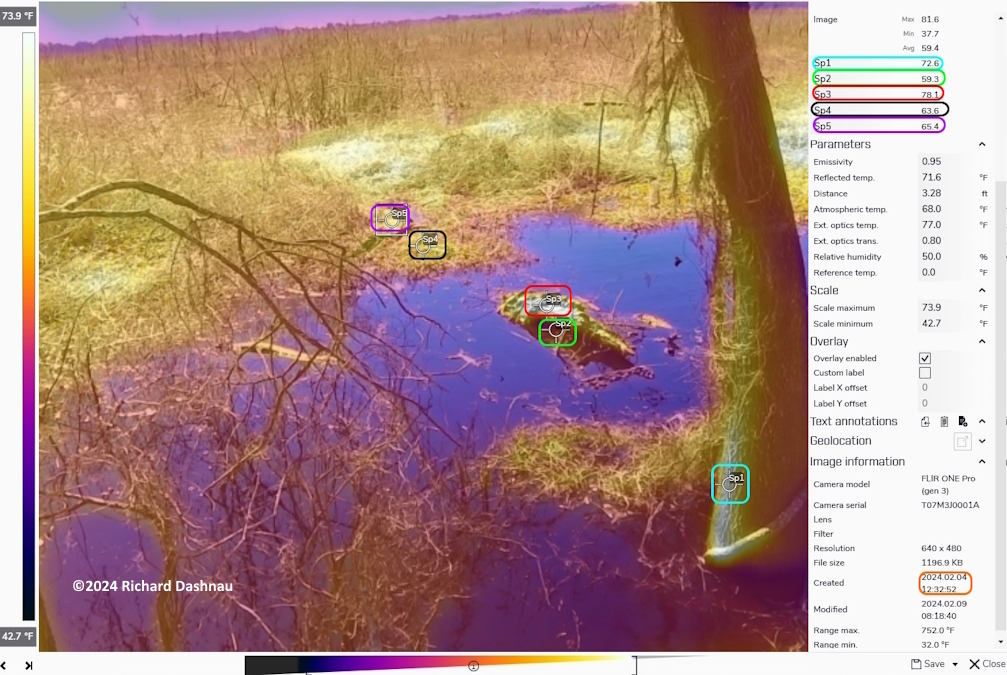
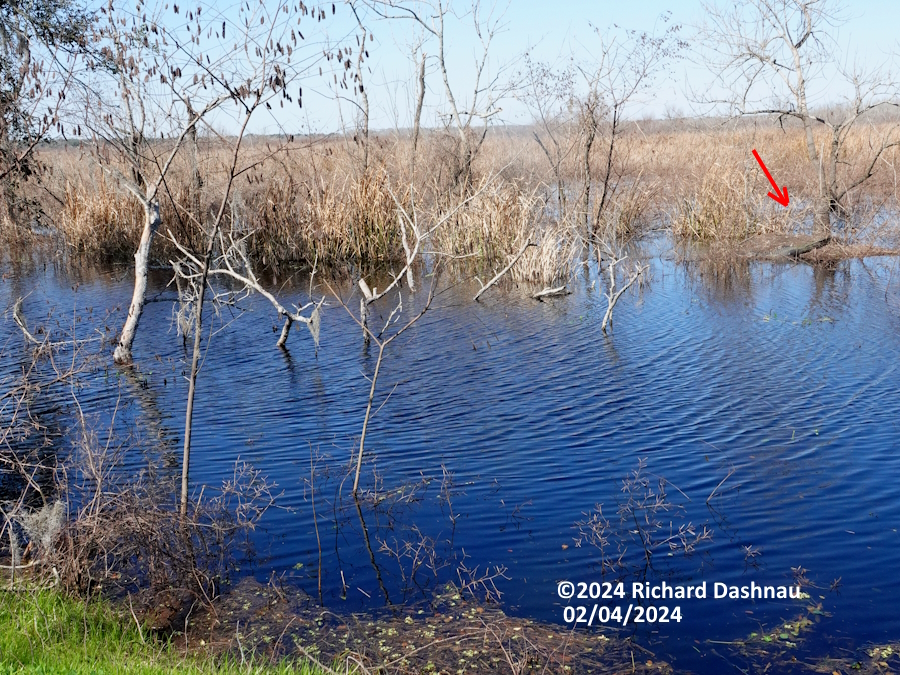
At the beginning of the summer, an alligator had built a nest there.
At the end, the pod had been living near the nest (because of
the water in front of it) until they moved
across to where they are now. The series of images below
show the nest in June, and then the area a various times through the
year.
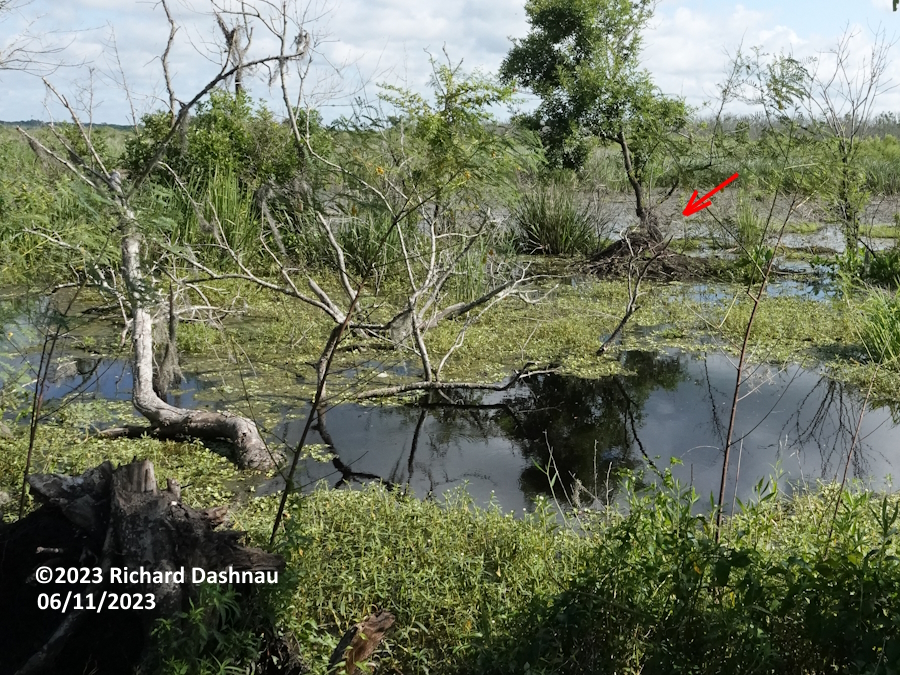
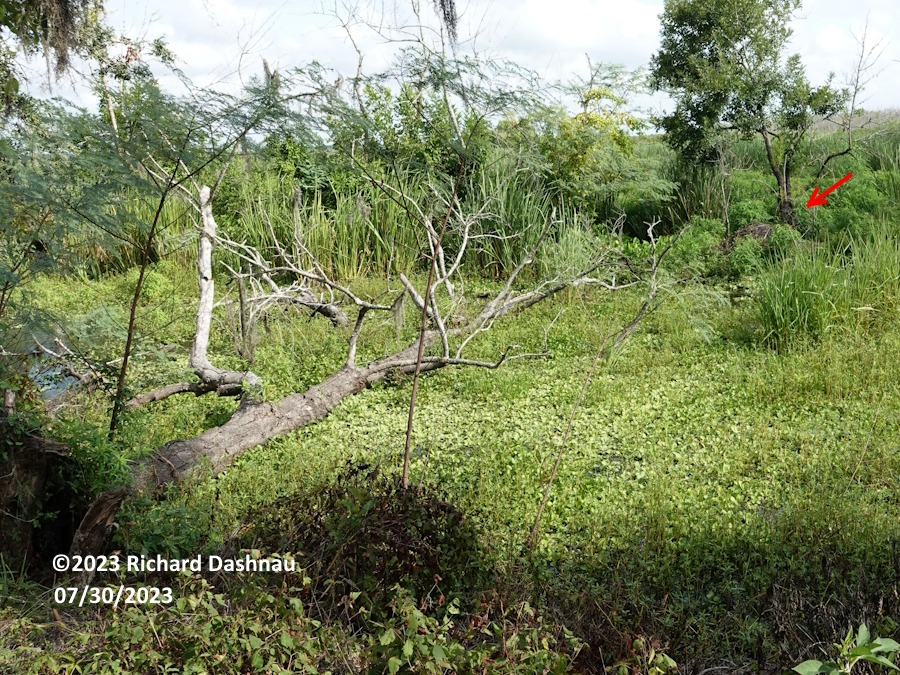
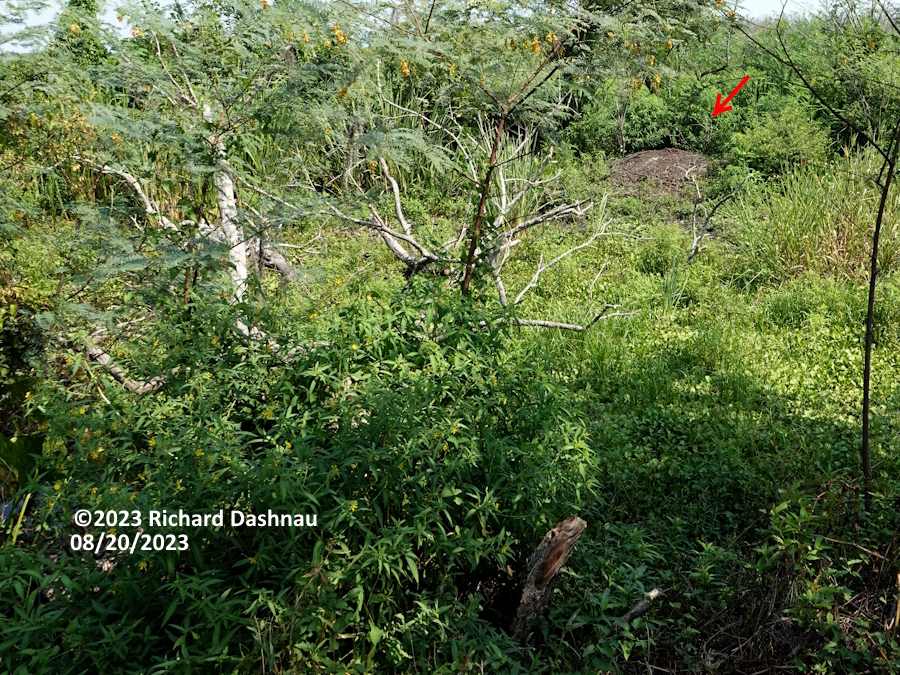
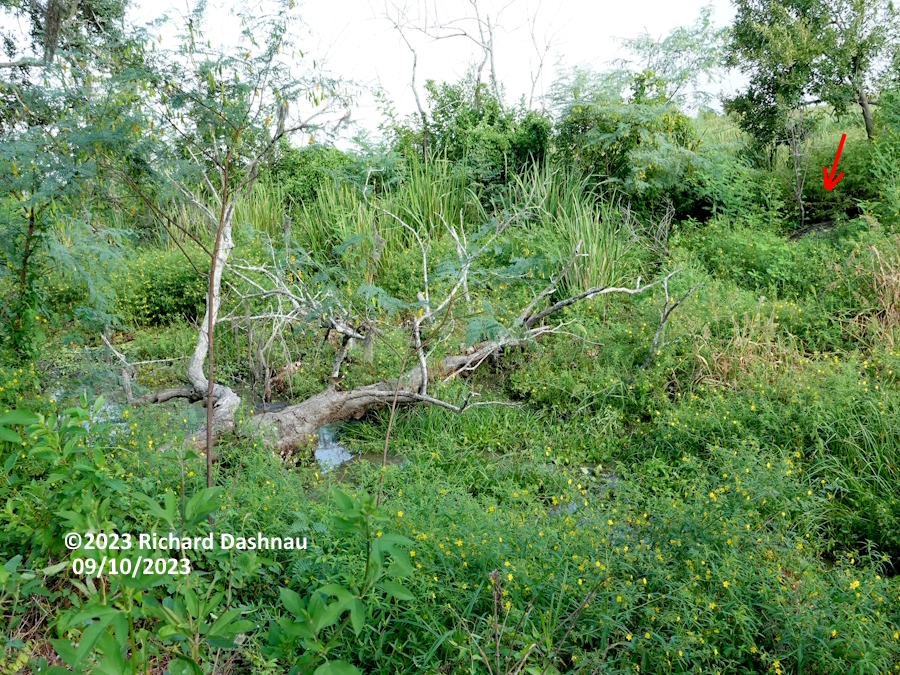
The water shrunk to a puddle, then to
nothing. I'm sure the mother was digging under the tree at the farther
side. I'd really thought that she'd stay there. But when
the water started to come back, the mother and the pod moved across
the trail to the South side of the trail--into Pilant Slough.
The arrow in each picture shows the nest.
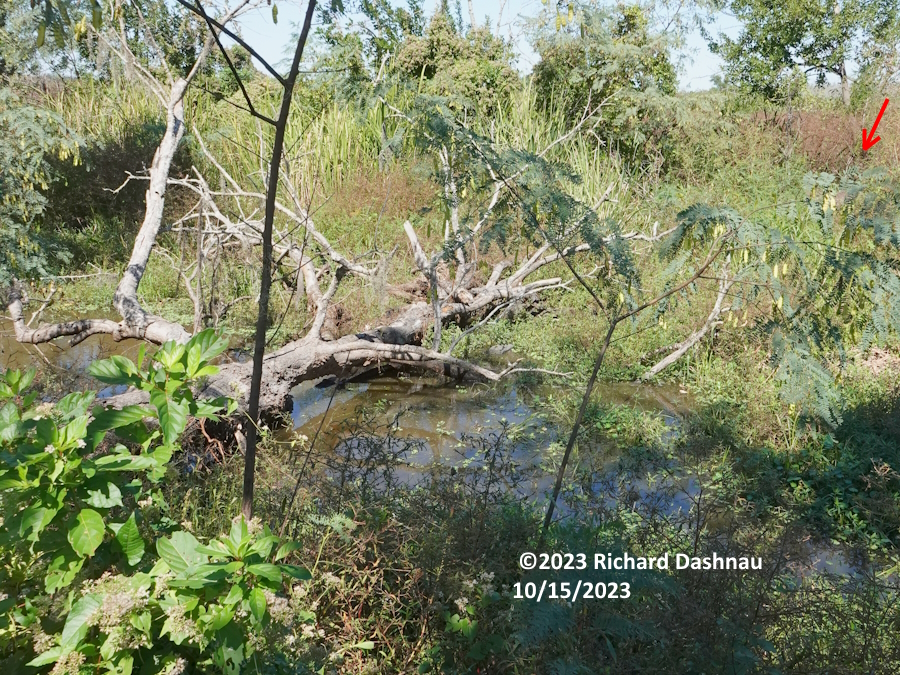
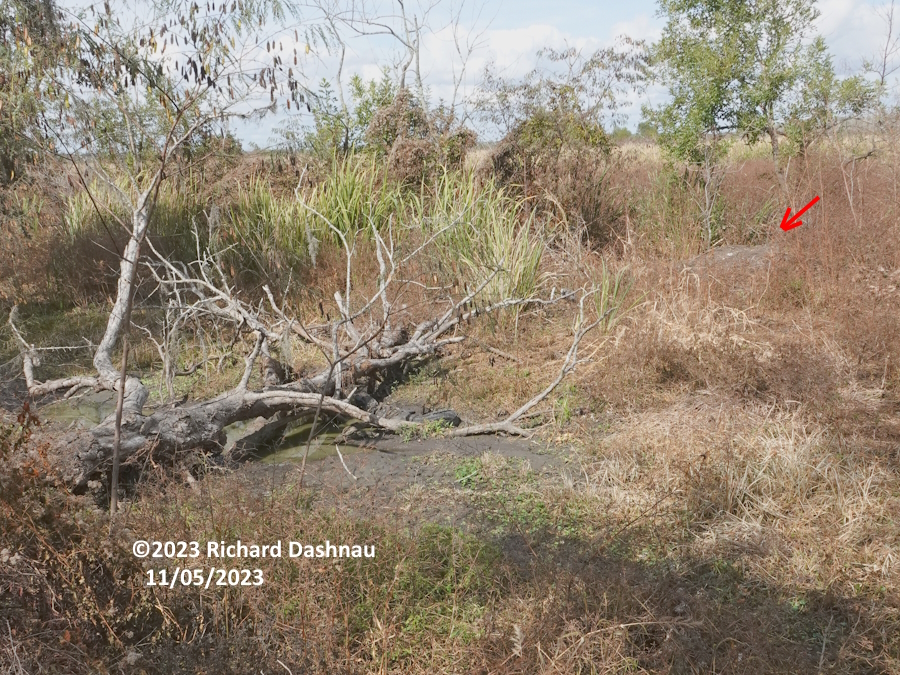
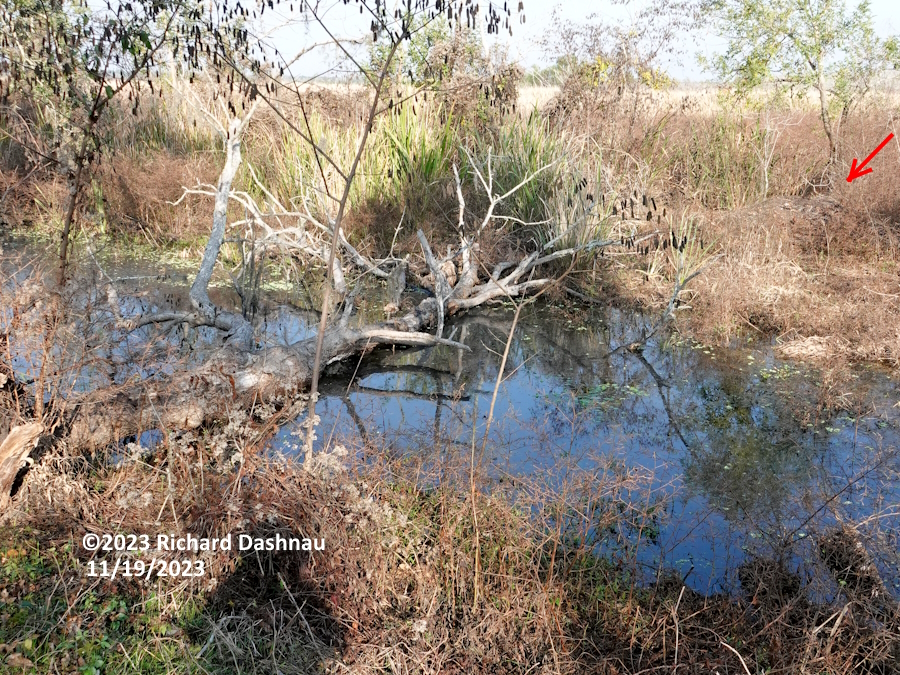
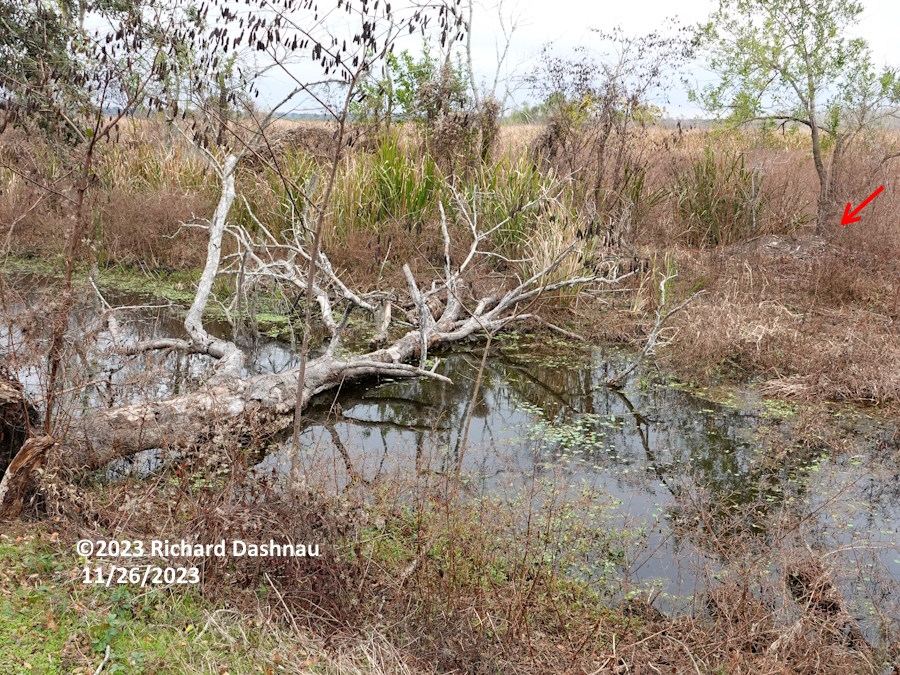
02/25/2024
Brazos
Bend State Park A beautiful day, where there were many
things to see (as usual). This post will briefly cover some of
the items
I went East along the Spillway trail, where I saw a Great Blue Heron (Ardea herodias) catch a small
Lesser Siren (Siren intermedia).
But it lost the Siren when it dropped the
amphibian to stab it again. The siren must have slid into the
plant mat, because the Heron struggled to pull it out, but failed.
When I got to the mother alligator and pod,
another large alligator was basking on the trail about 10 yards from
her. At one point, I counted 14 baby alligators on that stump,
and 10 or more moving among the plants
on the mat past the mother, as well as about 3 on a small stick
to the left.
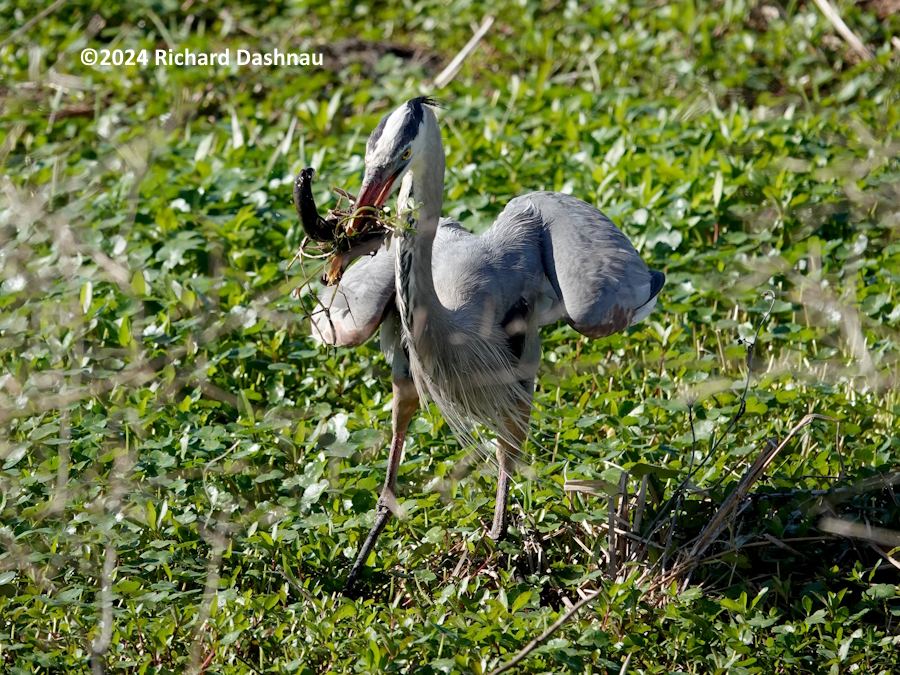
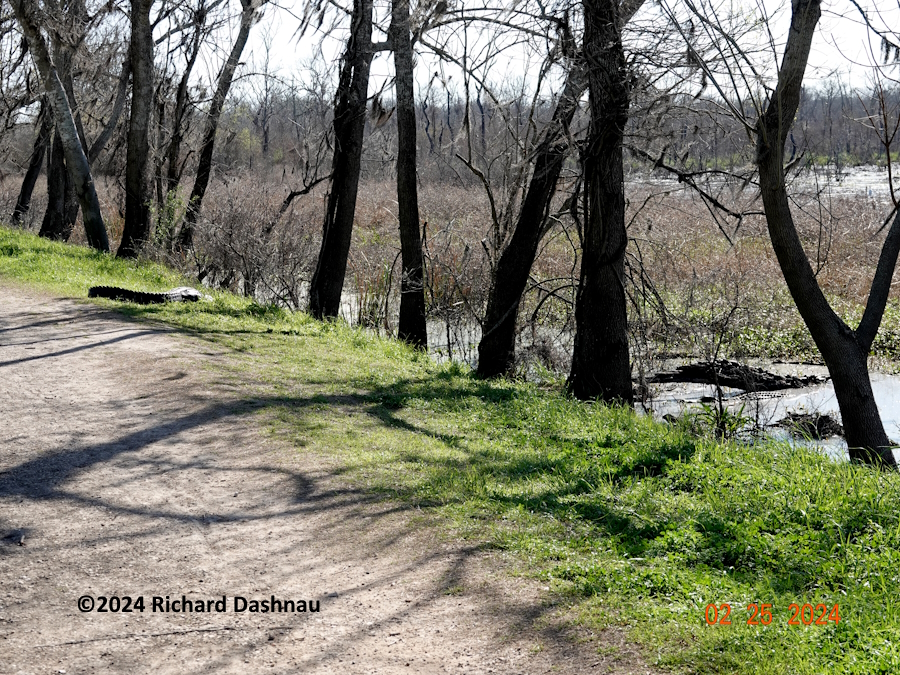
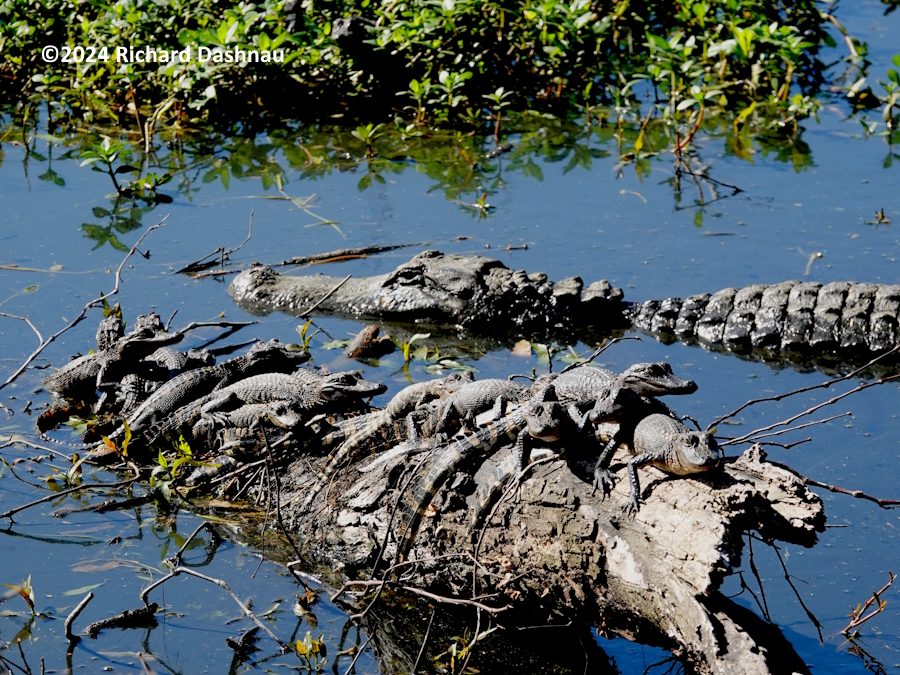
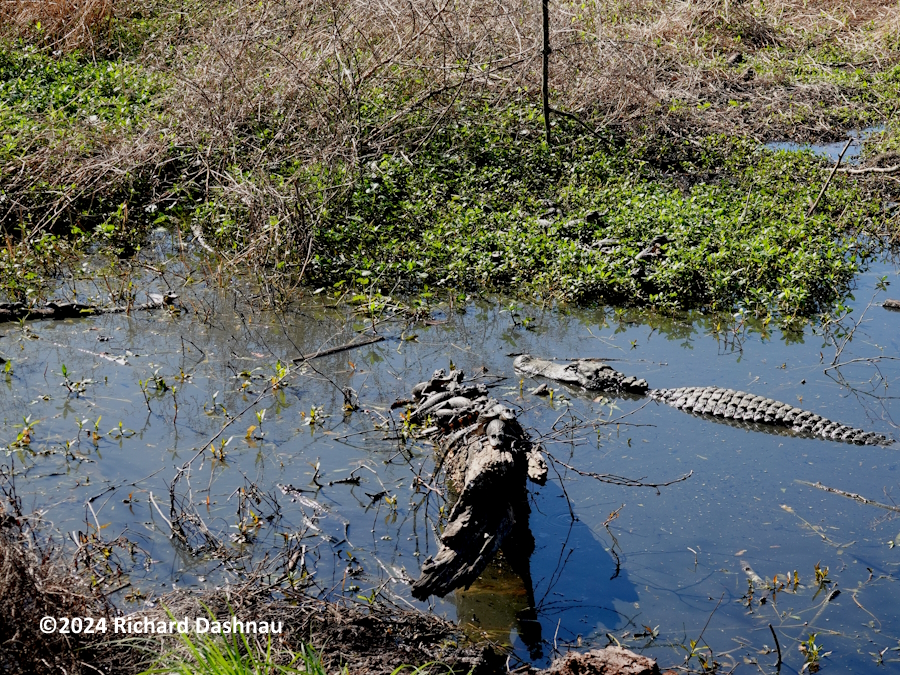
I stayed near the pod for about 4 hours.
The babies moved in and out of cover, while the mother
eventually moved onto the floating mat. The gator on the trail started
gaping--probably a "thermal gape" and I expected it to return to the
water. But, while it did move closer to the water, it didn't go in
while I was still there. At 10am, some
visitors that had just left me shouted "EAGLE" and a Bald Eagle
(Haliaeetus leucocephalus) was flying right above me! I'd been there
at least 90 minutes when I noticed a
darker mass in the snarled vegetation in front of me. An
American Bittern (Botaurus
lentiginosus) was resting in the cover! How long had that
been there? It slowly moved
off into thicker brush.
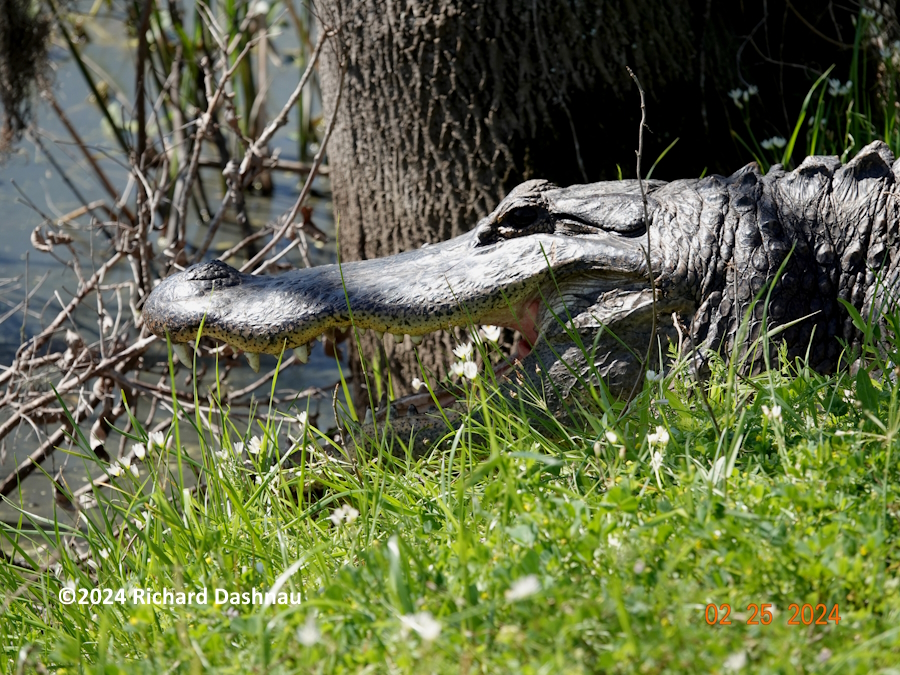
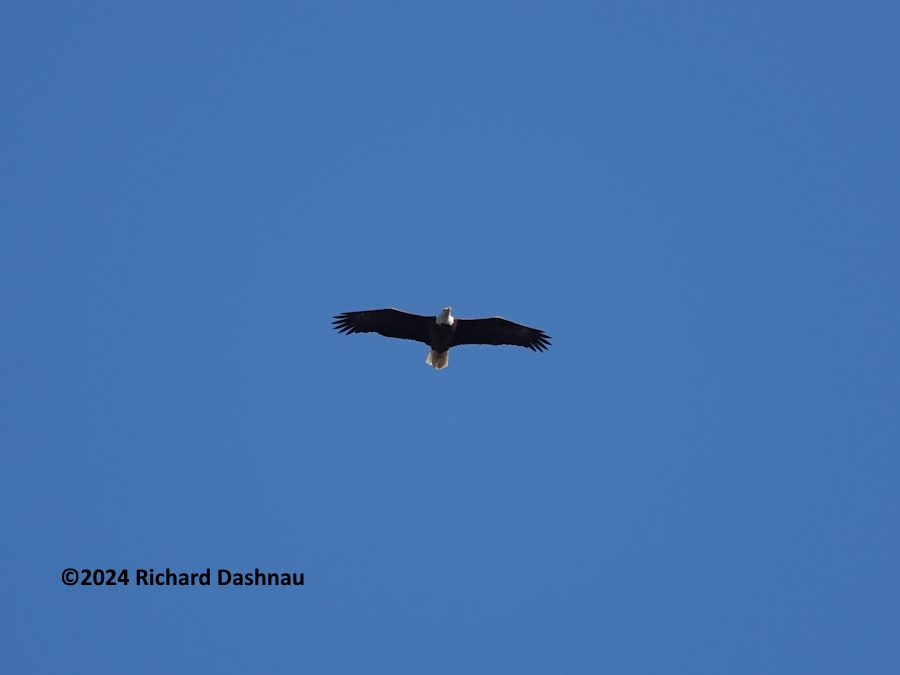
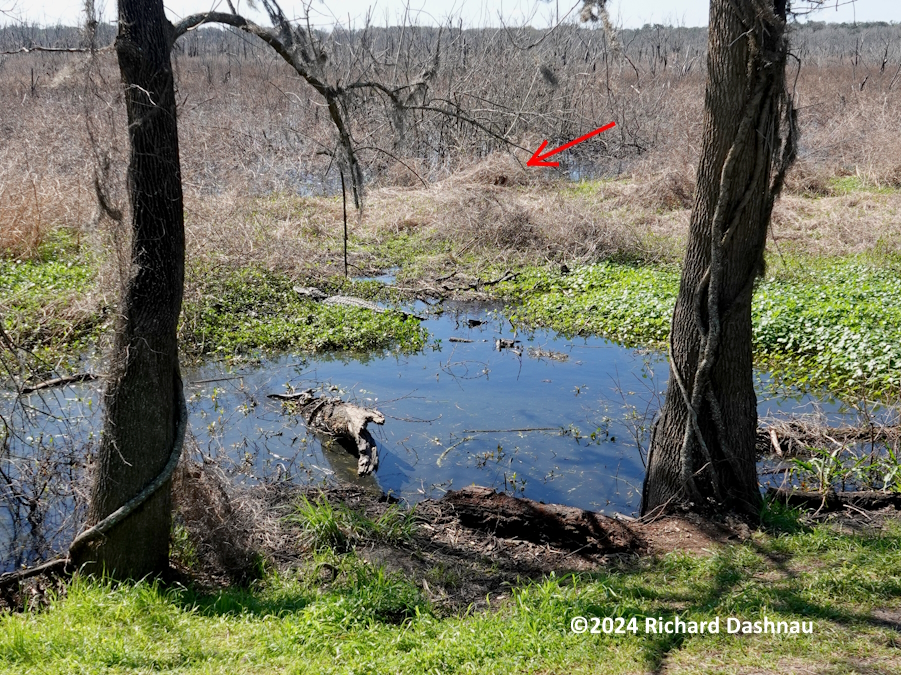
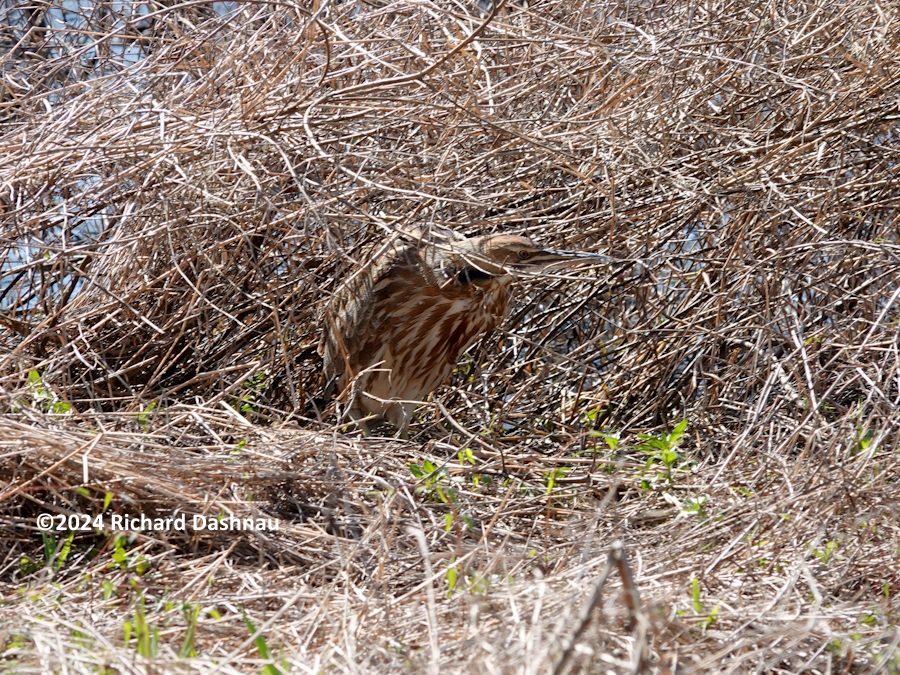
And,
this
page shows alligators at the park, on land, near various landmarks
at the park.
Go back to my main alligator page, Alligators
Go
back to my home page, Welcome to
rickubis.com
Go back to the RICKUBISCAM
page.
Go back to the See
the World page.


















































